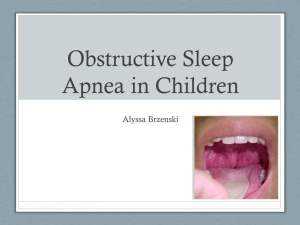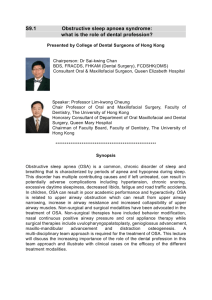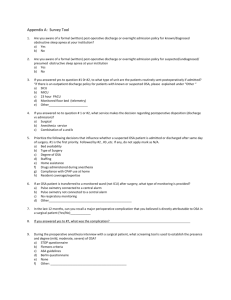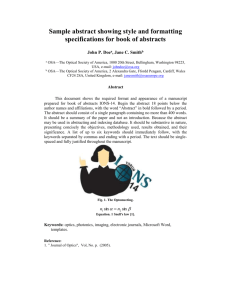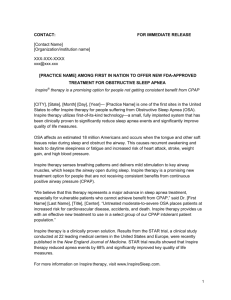Obstructive Sleep Apnea
advertisement
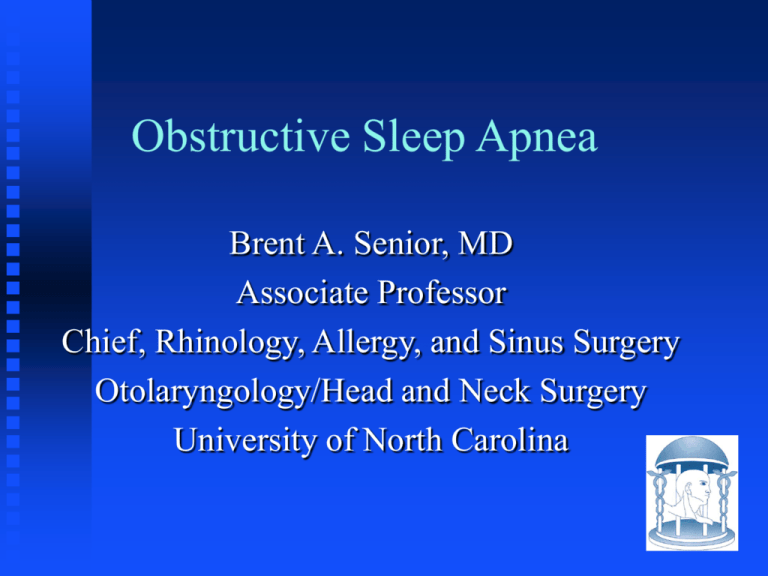
Obstructive Sleep Apnea Brent A. Senior, MD Associate Professor Chief, Rhinology, Allergy, and Sinus Surgery Otolaryngology/Head and Neck Surgery University of North Carolina What is OSA? Disorder of obstructed breathing occurring during sleep Apnea: cessation of breathing with respiratory effort lasting greater than 10s Hypopnea: decreased airflow of >70% Any decreased airflow with desaturation <90% Total apneas and hypopneas per hour = AHI or RDI or REI What is Significant OSA? Uh, I don’t know Most consider significant sleep apnea to be present with an REI > 15 15-25: Mild Apnea 26-40: Moderate Apnea >40: Severe Apnea Who’s Got It? NCSDR-1993 40 million Americans with chronic sleep disorder 20 million with occasional sleep disorder SDB (REI >5): 24% middle aged males 9% middle aged females OSA >15/hr: 4% middle aged males 2% middle aged females NEJM 1993; 328: 1230-35 Why is it so Important? Hypertension 25% of hypertensives have OSA (AI>5) Sleep Heart Health Study 6000 patients corrected for bmi, neck, EtOH • Nieto, et al. JAMA 283 (14): 1829-36, April 2000 SDB (including snoring) and Htn correlate 1700 patients • Bixler, et al Arch IM 160 (15): 2289-95, 2000 Sleep 1980; 3: 221-4 BMJ 1987; 294: 16-19 Health Impact MI REI >20 independent predictor of MI 223 German males with angio confirmed CAD • Schafer, et al. Cardiology 92(2): 79-84, 1999 Increased mortality in CAD patients 5 y study (Sweden)-62 patients; 19 with OSA (RDI 17) • OSA mortality: 37.5%; Non-osa mortality: 9.3% • Peker, et al. Am J Resp Crit Care 162 (1): 81-6, 7/2000 Health Impact CVA REI severity is independent predictor of Stroke 128 patients (UM)- 75 stroke; 53 TIA 62.5% with AHI >10 with stroke vs 12% controls • Bassetti, C et al. Sleep 22(2): 217-23, 3/1999 Health Impact Death AI<20, at 8y follow-up: 4% mortality AI>20, at 8y follow-up: 37% mortality treatment with trach or CPAP: 0% mortality Chest 1988; 94: 9-14 NCSDR 1993 38000 CV deaths related to OSA per year Societal Impact Societal Impact 75% of 75000 screened will be diagnosed with OSA ($275 million) Fragmentation of sleep occurring with SDB increased daytime sleepiness, decreased intellect, behavioral and personality changes, enuresis, sexual dysfunction Am J Resp Crit Care Med 1996; 153: 1328-32 Societal Impact Increased Traffic Accidents simulated driving: SDB ~100x more likely to drive off the road Acta 7x Otolaryn 1990; 110: 136ff increased risk of auto accidents Clin Chest Med 1992; 13: 427-34 Societal Impact Reaction times with OSA equivalent to a normal control who was legally intoxicated (ABL >0.8) Powell NB et al. Laryngoscope. 109(10):1648-54, 1999 UPPP decreases ORL the number of MVA 1991; 53: 106-111 Laryngoscope 1995; 105: 657-61 How’s it Diagnosed? History, Physical Examination, and Sleep Study History Disrupted sleep, restless sleep, awaken with gasping and choking Loud snoring Tired, inappropriate falling asleep Witnessed apneas History Associated Complaints Weight changes Thyroid/Growth Hormone abnormalities GERD Habits sleep schedule EtOH PMH/Meds Hypertension Sedatives; Antihistamines Physical Exam Height and Weight (BMI) BMI=[703.1 neck x weight(pounds)] / [Height (in)2] size Face-retrognathia Nose Oral cavity- palate, uvula, tonsils/pillars, tongue, occlusion Physical Examination Physical Examination Fiberoptic Nasopharyngolaryngoscopy Determines level of obstruction Provides estimate of degree of obstruction Technique supine (i.e., in a sleeping position) at FRC-point of maximal relaxation snore maneuver Mueller maneuver- inspire against a closed airway Evaluation Key Features of the History and Exam History (105 patients) apnea reported by bed partner (p<0.01) awakes with choking (p<0.005) hypertension: dias >95 (p<0.01) Exam BMI>30 All: (p<0.01) sensitivity 92%; specificity 51% Am Rev Resp Dis 1990; 142: 14-18 Objective Sleep Monitoring Rationale: Difficulty predicting OSA by H&P with no EDS Loud snoring and witnessed apneas identify OSA 54-64% of the time Sleep 1988; 11: 430-36 H&P predict OSA only 60% of the time Sleep 1993; 16: 118-22 How To Treat? Minimal intervention Drop the Weight! Dental Appliances Variable success rates, though probably more useful for mild apnea ?compliance Interventional CPAP Surgery CPAP The “Gold Standard” in the treatment of OSA Works the best in the most people Positive pressure ventilation functions as a pneumatic splint for the collapsing upper airway But... compliance is very poor 159/214 (74%); mean 5.6 h/night; 77-89% compliance (!) Krieger. Sleep 15 (6 Suppl) S42-6, 1992 Surgery Tracheotomy An incision in the trachea Cures OSA nearly 100% of the time Prior to 1980, it’s all we had; still useful for severe apneics Remove TissueUvulopalatopharyngoplasty (UPPP) First successful alternative to tracheotomy 12 individuals preop AI 54 +/- 28 postop AI 28 +/- 28 8/12 with post-op AI<20 • Fujita et al. Otolaryngol HNS 1981; 89:923-34 Remove Tissue-Other Surgeries Laser Midline Glossectomy Palatal Somnoplasty LAUP Radiofrequency tongue base reduction Woodson, et al, AAO 2000, Washington DC 18 patients completed protocol, average 15,696 J • REI decreased from 45.3 to 33.3 Enlarge the Bony SpaceOther Surgeries Genioglossus Advancement/ Hyoid Repositioning Success ~80% (11-18mm) Less effective with RDI >60 Maxillo-mandibular Advancement Particularly useful in the setting of hypopharyngeal obstruction (Fujita 2 or 3) Best results when performed following “Stage 1” surgery Complication Avoidance All OSA patients are at risk of Airway Obstruction (even mild) Minimize risk: Expect intubation disaster Pharyngeal procedure with nasal procedure increases risk regardless of apnea severity Mickelson and Hakim, Oto HNS 119: 352-6, 1998 Amount of intraoperative narcotic- worse with greater apnea severity Esclamado, Monitor Laryngoscope 99: 11-29, 1989 post-op with continuous oximetry Summary OSA is a potentially life-threatening disorder that demands proper evaluation Components of that proper evaluation include detailed sleep history, PE, and endoscopic evaluation Objective sleep evaluation is required prior to intervention Summary Treatments include Conservative Weight CPAP Surgery non-interventional techniques loss, dental appliances
